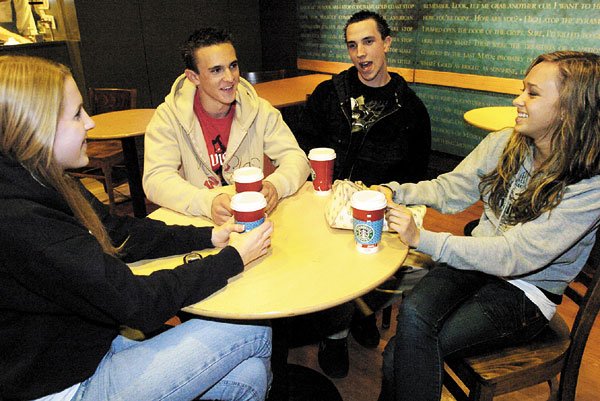Caffeine and sugary drinks keep Gilroy teens abuzz
If it weren’t for caffeine, says 16-year-old Amanda Spellman, she couldn’t juggle her brain-bending coursework with field hockey and basketball practice, couldn’t pull all-nighters and knock off four hours of homework each night.
“Oh yeah,” she says. “I’m addicted.”
For most teens, the drug of choice isn’t marijuana, cocaine or meth: it’s caffeine, by way of frothy Frappuccinos, trendy energy drinks or the old-fashioned cola. While the risks are milder, teens’ rising caffeine consumption and the sugar packed into many potent drinks has some nutritionists concerned.
“Many teens and adults would be surprised to find out how much caffeine they’re getting,” said Bonnie Liebman, Director of Nutrition at the Center for Science in the Public Interest (CSPI.) “There’s good evidence it stunts growth, and it definitely can cause insomnia.”
It takes about 100 mg of caffeine to perk up, but a typical 16-ounce coffee contains 270 mg of caffeine. A Starbucks 16-ounce kicks in with anywhere 260 to 550 mg of caffeine, according to different CSPI estimates; energy drinks such as Daredevil and Go Fast deliver more than 10 mg of caffeine per ounce. Both sell big among Gilroy teens, who chug caffeine for work and play.
“An energy drink can give you the same buzz as a beer, and the same nausea afterwards,” said Michael Simpson, 20. He started drinking SoBe No Fear drinks at age 18, passing around cans with friends in Morgan Hill. If your friends drink energy drinks, he said, you do, too.
“I’d drink two in a row, and then we’d go at the punching bag until we passed out,” he recalled. His heart fluttered; his breath grew short. “Some of my friends would drink a whole case.”
Meanwhile, coffeeshops have become de facto teen hangouts in Gilroy. At It’s a Grind, dozens of teens trade gossip over white chocolate mochas on Saturday nights. Barista Ashley Holtz said teens often spend more than an hour at the shop.
“We have to kick them out when we close,” added coworker Janette Perez, who grew up in Gilroy. As a teenager, she said, “You don’t want to go to a park – you’re too old. You can’t go to a bar – you’re too young.” Instead, “everyone meets here.”
Unlike McDonald’s or KFC, coffeeshops retain an aura of bohemian cool, a sophistication that’s appealing to teens, said Temple University professor Bryant Simon. He’s currently writing a book on Starbucks, and has visited more than 300 in eight countries.
“Teens represent among the most loyal Starbucks patrons,” he said. Some list their favorite Starbucks drinks on their MySpace pages, alongside their favorite bands and labels. “It filled a void in teen’s lives: a casual, easy-to-go place where they can talk and play out their ideas about what it is to be an adult.”
Holtz says she grew up in Gilroy’s coffee shops. As a kid, she’d sit with a cup of whipped cream while her parents drank java; as a 12-year-old, she started drinking decaf, imitating her older brother.
“You feel a little grown up, without being a grown-up,” Holtz said.
It doesn’t hurt that coffeeshops don’t shoo teens away. Both Starbucks and It’s A Grind aspire to a living-room feel, where teens can lounge at ease. Maggie Swaton, assistant store manager at Starbucks Coffee on First Street, said her shop is a safe place for kids to go. Baristas keep an eye on them, she said, but not too closely for comfort.
“It’s a place parents feel really comfortable with their kids going,” Simon said, citing the chain’s clean-cut staff and breezy floor-to-ceiling windows. “What parents should be concerned about, though is developing caffeine addiction. It doesn’t matter how much you mask that drink – it’s still a drug.”
Yet caffeine isn’t labeled like a drug. Companies that add caffeine are required to list it among their ingredients, but labels don’t specify how much has been added, nor the total amount of caffeine, natural and added.
Caffeine content can be surprising, by CSPI’s estimates: a SunKist orange soda packs more caffeine than a Pepsi, while a Minute Maid Orange soda has none. A Dannon Coffee Yogurt offers the same buzz as a 12-ounce can of Coke; a Dannon Light Cappuccino is decaf.
What’s more, caffeine content can vary wildly, even within brands. From one day to the next, a cup of Starbucks coffee, bought from the same store, can double in caffeine content, according to a study published in the Journal of Analytical Toxicology.
“There’s a consensus that some people, especially pregnant women, should limit their caffeine,” said Benjamin Cohen, a CSPI senior staff attorney, “but there’s no way they can do that, because they can’t figure out how.”
In 1998, CSPI petitioned the FDA to label caffeine content in foods, citing the health risks to pregnant women; a year earlier, the American Medical Association passed a resolution in support of caffeine labeling. Two years ago, the FDA listed caffeine labeling as a priority project. Today, CSPI’s petition is still under review, and nothing has changed.
Meanwhile, caffeinated drinks teens crave are raking in cash for companies. Frappuccinos, the gateway drink for many teens, made $157,935,900 in 2005; Red Bull, the top-selling energy drink, scored $225,700,000, according to Beverage World’s 2005 State of the Industry report. Sales of energy drinks skyrocketed, growing 77 percent in 2005.
Liebman of CSPI said she’s less worried about caffeine consumption than the fat and sugar in the sweet, creamy drinks teens favor. Simon says many teens say they graduated from hot chocolate to Frappuccinos to lattes. Along the way, they’re slurping up a lot of calories.
“A Starbucks Cafe Mocha Venti is a quarter-pounder with cheese in a cup,” said Liebman. “A Banana Coconut Frappuccino has 550 calories in a 16-ounce drink – and you can get a 20-ounce.”
Nutritionists have long linked soft drinks to child and teen obesity: in 2003, the University of California’s Office of Research found that sodas made up half the sugar in teens’ diets. Athletic teens like Spellman say they’ve swapped out soda for coffee, for health reasons, but the blended mochas they love aren’t exactly SlimFast. Meanwhile, teens haven’t got milk: only 10 percent of girls and 29 percent of boys are getting their recommended dose of dairy.
“These kids don’t need the sugar,” said Holtz, who’s seen plenty of wired teens from behind the counter at It’s A Grind.
But as Spellman juggles trigonometry homework with three-hour field hockey practices, she says she definitely needs the buzz.
“Caffeine plays a huge role in my life,” she said, “from morning ’til bed.”














